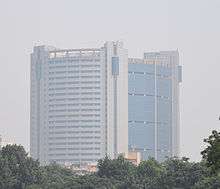Municipal Corporations in India
 |
| This article is part of a series on the politics and government of India |
|
|
|
Government of India portal |
In India, Municipal Corporations or City Corporation or Mahanagar Palika or Mahanagar Nigam are urban local government that works for the development of a city, which has a population of more than one million (ten lakh). The growing population and urbanization in various cities of India were in need of a local governing body that can work for providing necessary community services like health care, educational institution, housing, transport etc. by collecting property tax and fixed grant from the State Government.
The 74th amendment made the provisions relating to Urban Local Governments (Nagarpalikas).
Three Tier Structure:
- Municipal Corporations
- Municipal Councils
- Nagar Panchayats


Terms used for Municipal Corporation in India
In India a Municipal Corporation is called by different names which varies from state to state(oweing to the official language of the state or due to other regional language variations) all of which are translated to "Municipal Corporation" in English, these names including Nagar Nigam(in Delhi, Uttar Pradesh, Bihar, Rajasthan, Haryana), Mahanagar Palika(in Maharashtra, Goa, Karnataka), Pouro Nigom(in West Bengal), etc. The term Nagar Palika Nigam is used in Madhya Pradesh for Municipal Corporation. In Tripura, the sole Municipal Corporation of the city of Agartala is called Agartala Pur Porishod in Bengali. Also, the Vadodara Municipal Corporation is typically called by the name "Vadodara Mahanagar Seva Sadan". The detailed structure of these urban bodies varies from state to state, as per the laws passed by the state legislature(Vidhan Sabha) but the basic structure and function is almost the same. Under the panchayati raj system, it interacts directly with the state government, though it is administratively part of the district it is located in.
Constitution

Each Municipal Corporation has a committee consisting of a Mayor with Councillors. They are formed under the Corporations Act of 1835 of Panchayati Raj system which mainly deals in providing essential services in Metropolitan Cities. The no. of councillors depend upon the area and population of the city that minimum of 3,00,000. Municipal Corporation members are elected from the several wards of the specific city on the basis of adult franchise for a term of five years. There are seats reserved for Scheduled Castes, Scheduled Tribes, backward classes and women. The Councillors are chosen by direct election from electoral wards in the Municipal Corporation.
The largest corporations are in the six metropolitan cities of India, viz. Delhi, Mumbai, Kolkata, Chennai, Bangalore and Hyderabad and among these Mumbai is the most populous and largest metropolitan city of India. These cities not only have a large population, but are also the administrative as well as commercial centres of the country.
Administration
Mayor is the head of the Municipal Corporations in India. The Municipal Commissioner is the official in charge of this organization. Executive Officers monitor the implementation of all the programs related to planning and development of the corporation with the coordination of Mayor and Councillors.
Mayor and Councillors
This model is also known as the Commissioner system, taking its name from the role of the city administrator who is generally a state-appointed officer. In such a system the Mayor in the Municipal Corporation is usually chosen through indirect election by the Councillors from among themselves for a term of one year, which is renewable.
The Mayor generally lacks executive authority. This is due to the British roots of the system that remain from the time when the administrator was the representative of the colonial power, not to the fact that it operates under a council-manager system whereby the executive would be accountable to the elected representatives. In this context, the indirect election of the Mayor combined with his short one-year tenure renders the role little more than that of a figurehead.
Councillors act by committee, the most powerful being the Standing Committee with its role of the steering committee exercising executive, supervisory, financial and personnel powers. It is composed of elected members varying in number between seven and sixteen through a system of proportional representation of Councillors.
The executive arm of the corporation
The Municipal Commissioner is the chief Executive Officer and head of the executive arm of the Municipal Corporation. All executive powers are vested in the Municipal Commissioner. Although the Municipal Corporation is the legislative body that lays down policies for the governance of the city, it is the Commissioner who is responsible for the execution of the policies. The Commissioner is appointed for a fixed term as defined by state statute. The Commissioner’s term in office can be extended or reduced. The powers of the Commissioner are those provided by statute and those delegated by the Corporation or the Standing Committee. This is the closest that India has come to the council-manager system, with the critical difference of accountability of the manager to the elected arm of government; and the fact that the power of the unelected executive arm of government is thus weighted in its favour.[1]
Functions

- Water supply
- Hospitals
- Roads
- Over bridge
- Street lighting
- Drainage
- Solid waste
- Fire brigades
- Market places
- Records of births and deaths
it also helps in education and primary health care
Sources of Income
Its sources of income are taxes on water, houses, markets, entertainment and vehicles paid by residents of the town and grants from the state government.
See also
References
Sources
Our Civic Life (Civics and Administration) Maharashtra State Bureau of Textbook Production and Curriculum Research, Pune
| ||||||||||||||||||
